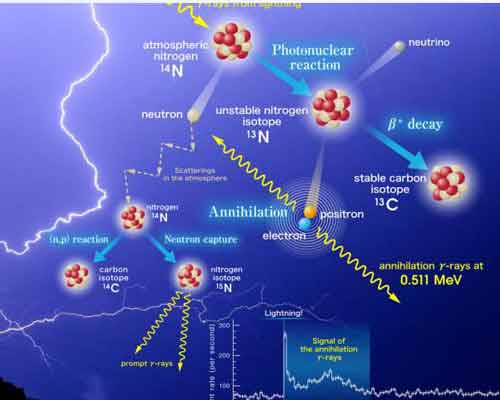News
Positrons Born from Photonuclear Reaction in Thunderbolt Updated in February 2018
Typical summer climate in Japan calls for thunderstorms. People who say so are probably those from the Pacific coasts of the country. In Hokuriku or northwestern Japan facing the Japan Sea, thunderstorms typically occur in wintertime. Winter bolts coming from low winter thunderclouds are called “snow raisers (yuki-okoshi)” or “jackfish shockers (buri-okoshi).” The thunder does not keep on rolling in the background like the pacific summer storms. They are mostly furious “one-shot” bolts that directly strike the ground with an explosive sound.
Research group headed by Teruaki Enoto (Kyoto University Hakubi Center-Special Associate Professor) found a strange phenomenon occurring inside the thunderclouds during such winter storms. They detected “positrons” which are rarely seen now on earth. There used to be many positrons a long time ago when the universe was born.
In junior high school science, we learn that substances are made of small particles of atoms, and that each atom is made of a "nucleus" with positive electricity and electrons with negative electricity. By standard notions, electrons are charged with negative electricity. However, when the universe was born, there were plenty of electrons with positive electricity. They are called “positrons.” Electrons and positrons are born in pairs from the energy of light. When electrons and positrons meet, they disappear and turn into light energy. 13.8 billion years ago, when the universe was born with a mass of intense energy, there were many electrons and positrons. But positrons eventually disappeared and negative electrons started to dominate. Consequently, positrons are rarities on our earth today.
Since 2006, Enoto’s team has been conducting observations to measure radiation falling out from thunderclouds in the city of Kashiwazaki-shi, Niigata Prefecture. The detector recorded a gamma ray of “0.511 mega electron volt” immediately after the lightning struck the city on February 6, 2017. Gamma ray is a type of radiation. “Mega electron volt” is the unit to measure energy. A Gamma ray of “0.511 mega electron volt” is a typical reaction in which electrons and positrons disappear together. This evidently illustrated that positrons were present.
Analysis showed that this positron did not happen to fly in from outer space, but was born inside the thunder. Among the thunder clouds, there are parts that are rich in positive electricity and others that are rich in negative electricity. Electrons move as fast as the speed of light. During this process, gamma rays are generated. Then, the gamma ray collides with the nitrogen atom in the atmosphere and changes the structure of the nucleus. The positron is born from such reactions. When this positron combines with electrons, they disappear to generate gamma rays of “0.511 mega electron volts.”
Flow of electricity is equal to the flow of electrons. During electricity flow or chemical reaction (e.g. sodium chloride formed by hydrochloric acid and sodium hydroxide), the nucleus does not change. A typical example of nuclei change would be nuclear fission, where uranium nuclei are broken by nuclear power. Such reaction accompanying nucleus change, is completely different in comparison to electricity flow and chemical reactions. Such nuclei change actually occurred during the lightning and positrons came into existence.
Inside the thunderclouds, portions with positive electricity and portions with negative electricity are unevenly distributed. When the amount of accumulated electricity exceeds a certain limit, electricity cannot withstand any longer and electricity flows inside the clouds or between the clouds and the ground. This is the basic mechanism of thunder which has been believed so far. However, what triggers thunder directly is still unclear. Perhaps particles associated with the “nuclear reaction” explained in this research could be related to the cause. We must say that this research opened up a whole new field in front of us.
www.nature.com/articles/nature24630https://www.hakubi.kyoto-u.ac.jp/eng

(i.e. pair annihilation). (Provided by Enoto’s research group)
Photos courtesy of Japan Science and Technology Agency







